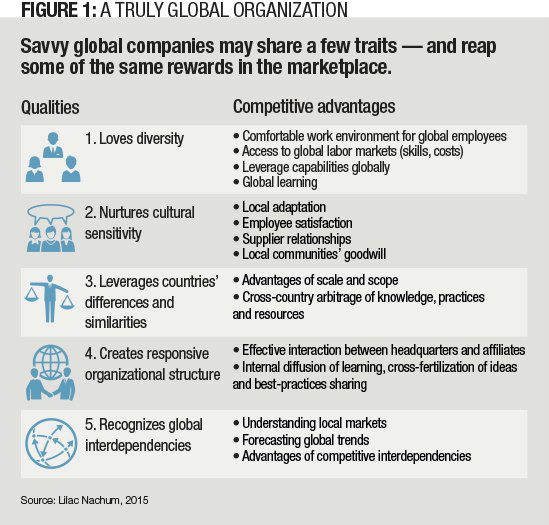For learning leaders, it is a self-evident truth that curricula must be closely aligned with companies’ objectives. But in global training, we are far from this goal.
This is both a problem and an opportunity because there are huge gains to be made by giving people a more global skill set. Global training is important, and corporate universities can provide what’s needed if chief learning officers rethink corporate curricula.
Companies around the world have gone global at accelerated speed. According to the 2014 United Nations World Investment Report, the number of multinational companies worldwide has grown from 18,500 in 1985 to more than 80,000 in 2014, and the gross domestic product shares of goods, services and investment that cross national borders have doubled during this period. Corporate training, however, has not kept pace with these developments. Neither faculty nor curricula are prepared to meet the needs of the global corporations they serve.
This leaves companies ill-prepared for a world where the biggest business opportunities often reside outside their home countries. According to 2014 data from the World Bank, for U.S. companies, 95 percent of the world’s consumers and 75 percent of its purchasing power are outside the U.S. The shares are higher for companies in most other countries.
Similarly, in the labor market, the number of people employed outside home countries keeps growing, and there is an apparent shift to a transfer of talent that runs both ways from exporting homegrown managers abroad. Data collected by the U.S. Bureau of Economic Analysis in 2013 show the number of foreigners employed by U.S. multinational companies has tripled over the past three decades. These developments increase the challenge of managing a diverse and geographically spread workforce.
Most senior executives know their companies have a problem when it comes to global expertise. More than 75 percent of 1,200 executives surveyed for PricewaterhouseCoopers’ “Talent Mobility 2020” study found the training and development in their organizations inadequate for their global activity. Only 7 percent of the executives surveyed by Ashridge Business School (U.K.) and the United Nations believe their organizations’ global leadership development programs meets their needs.
Global Training Agents
This state of affairs impedes companies’ ability to respond effectively to the growth and development opportunities inherent in a global marketplace. It also leaves them unprepared to deal with the challenges in such a world. Further, while companies may technically go global, they often navigate in the marketplace as if they are driving in fog without a GPS to guide them.
Corporate universities are uniquely positioned to develop the skills required for successful activity in a global world. They are best situated to deliver training that is responsive to companies’ distinctive strengths and weaknesses, and are rooted in their overall developmental goals. Because of the need for company specificity, market offerings for global training are not always suitable. In the Ashridge/U.N. survey, only 8 percent of executives said alternatives such as business school programs or consulting services are effective in developing the knowledge and skills global leaders need. Corporate universities, however, are consistently singled-out as the most appropriate agents for this undertaking. Some 80 percent of the executives in this survey selected them as their provider of choice for global training.
One question that remains unanswered is: Who is the right audience for such training? Companies often adopt too narrow of an approach to answer this question. To the extent they offer global training, they tend to restrict it to senior leaders or those directly engaged in international assignments. The problem with this approach is that senior leaders might not be in the best position to observe business opportunities across all functions within an organization, nor can they identify the most appropriate ways to take advantage of them. This is best achieved by the employees devoted to particular niches or units because they are most familiar with departmental subtleties.
Confining global training to people active internationally is also inappropriate because global issues have become a part of everyone’s job — those who work aboard and those who stay in the home country. Increasingly, most employees within organizations interact with people of different nationalities daily. Therefore, to be effective, global training programs have to include the entire organization.
What Should Global Curricula Look Like?
At the same time, however, the training needs of employees differ because of the global content of their jobs varies. Most companies would benefit from distinguishing among three employee categories and tailoring programs to fit specific needs: organizationwide, midlevel managers/affiliates and top-level executives and global function-area CEOs.

Global curricula should vary across companies in line with the nature of their business and the way they measure success and define the bottom line. What follows are general guidelines for company-specific global curricula design referencing the major goals, processes and learning outcomes for each element of the curricula. These outlines are deliberately flexible so they can be delivered via a variety of means, at varying levels of resource commitments.
Organizationwide: Create a globally minded organization. The goal here is to develop a corporate culture that nurtures an understanding of others and welcomes respect and empathy to differences, essentially creating a globally minded organization.
Following the process of global mindset development, this training could proceed in three stages. In the first stage, participants learn frameworks to identify national differences — in economics, political, legal and cultural dimensions — understanding their origin and analyzing them. This knowledge instills the foundations for development in the second stage: curiosity, sensitivity to differences and the ability to see opportunities where diversity is perceived as a source of learning and inspiration.
Lastly, participants develop interest in and aptitudes for creating relationships with different types of people. This improves employees’ ability to communicate effectively in a cross-cultural environment and engage comfortably with different types of people, including those in subunits located in different countries as well as with consumers and suppliers.
Midlevel managers/affiliates training: Bridge the local and the global.This training is targeted to managers of foreign affiliates who are responsible for building local resources in foreign markets, and who manage the tension between the global demand of the organization and those of foreign countries. The core objective of this program is to equip participants with tools to navigate between the often-conflicting demands of corporate headquarters and foreign markets, and create value by bridging their requirements.
Participants develop the ability to respond to local differences in keeping with the global principles of the corporation and its core values. They walk away with an improved ability to manage foreign operations as part of the global network of the corporation and to contribute to the organization’s overarching goals.
Top-level/function-area CEOs: Manage the global corporation from the center.This part of the curricula is designed for leaders who oversee the global operation of the organization and craft its global strategies. It evolves around the two major managerial tasks required to capture the potential benefits of global activity: identifying areas whereby global integration can create advantages, and creating the organizational structure that allows these potential advantages to materialize.
Many of the benefits of global activity require managerial action from the center. Free from the demands of local markets, senior leaders are in a position to identify possibilities for value creation via cross-country integration. Participants learn means to identify areas where cross-country differences could create competitive advantages, for instance through combinations of resources and the arbitrage among them.
They also learn to identify relevant similarities across countries, and offer advantages such as scale, scope and global market power. Participants develop the skills required to tackle the complex task of accomplishing a common goal in different countries, and exercise the mental flexibility required to implement this task via a multicountry lens.
The second major focus of this training program includes the acquisition of tools required to introduce structures and mechanisms that bring different subunits together and generate the synergies that create competitive advantages. These include means to coordinate activities, link capabilities across national borders and connect areas of specialization throughout the organization.
Properly designed and delivered, global curricula will yield significant, visible improvements in five major organizational qualities (Figure 1).
The challenge of developing an organization that can take advantage of global opportunities is immense. However, with the right development through its own corporate university, an organization can transform and improve in measurable ways, and reap the rewards.















